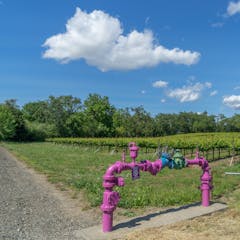
Articles on Water resources
Displaying 1 - 20 of 33 articles

New research shows turning northern rivers inland to irrigate Australia’s dry interior would not increase rainfall. This is another argument against the Bradfield scheme.

Climate change is putting pressure on Ethiopia’s largest city, Addis Ababa, and exposing people to disease and natural disasters.

Better monitoring of groundwater is important for sustainable management.

Oil and gas exploration pose a threat to the Okavango River Basin water resources. The Namibian and Botswana governments need to properly assess the risk of contamination.

The primary reasons for the systemic collapse include poor operation, defective infrastructure, the absence of disinfection chemicals, and lack of monitoring.

We detected 180 contaminants in treated and untreated water. None of those found in treated water breached human health guidelines, but we should not forget about potential impacts on the environment.

Australia’s emerging green hydrogen industry requires a secure supply of high-quality water. Competing demands for this scarce resource mean careful planning is needed to meet all water users’ needs.

Australian politicians have a history of opting for high-cost, high-emissions desalination projects. The Queensland government is still wary of using the largely untapped resource of recycled water.

New regulations for protecting water resources during oil exploration are inadequate and should be reviewed.

We need a radical rethink of water resource planning. Strategies should include reusing water and moving water physically to water-scarce areas.

South Africa’s dams are overflowing but the country is still facing water supply challenges.

Groundwater has the potential to support broad economic, humanitarian and social development in sub-Saharan Africa, as it has in other regions globally.

Long before climate change was evident, California began planning a system of canals and reservoirs to carry water from the mountains to drier farms and cities. It’s no longer enough.

Herat is home to an India-built dam that provides water for drinking, irrigation and bathing for much of western Afghanistan. If the Taliban control that water, they control the population.

As rivers run dry in the Rocky Mountains and the West, it’s easy to wonder where all the snow you see on mountain peaks goes. Some of it ends up in the air, but researchers aren’t sure how much.

It’s an ecological disaster, but my research shows we should not lose hope.

Treaties are needed to govern water resource allocation in the Nile basin region. For this to happen it’s critical to have accurate data on how much water there is.

Fracking in Botswana could have an impact not only the country’s groundwater, but also that of Namibia and South Africa.

Trends across the different rainfall zones can be linked to changes recorded for large-scale climate systems.

A court victory by an NGO against a South African municipality has laid bare the red tape and misgovernance that often burdens the process of issuing water licenses.
